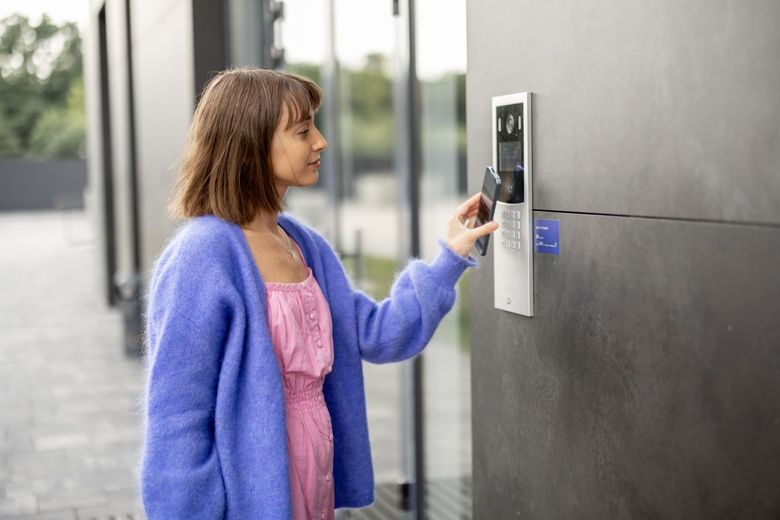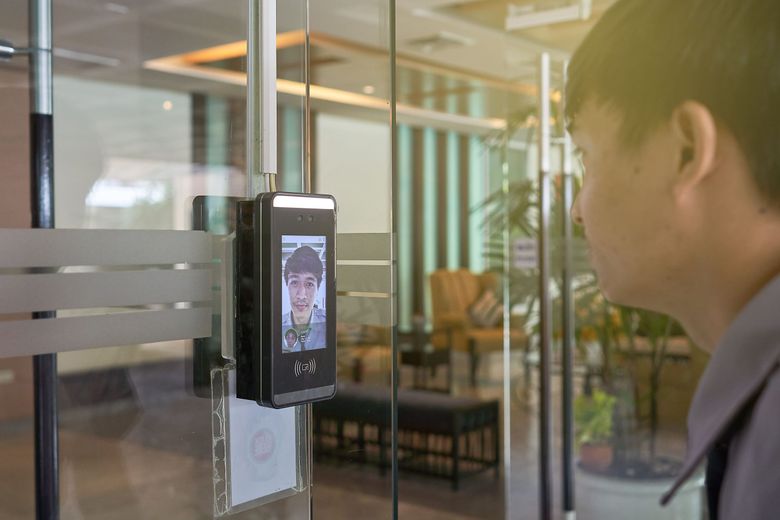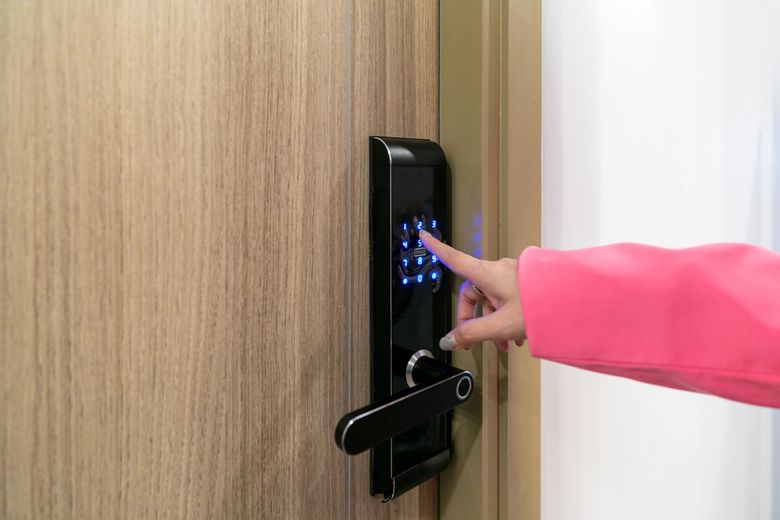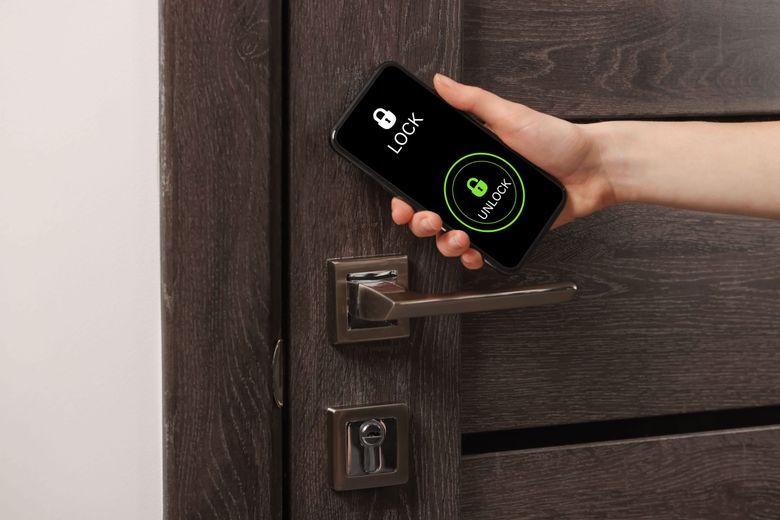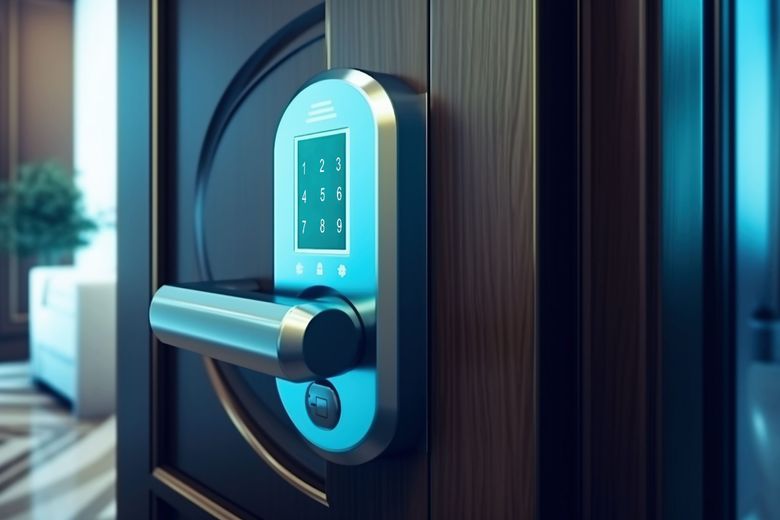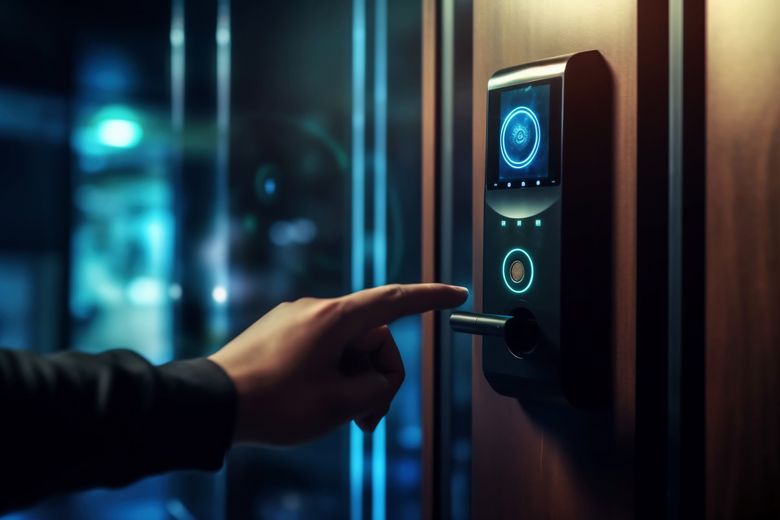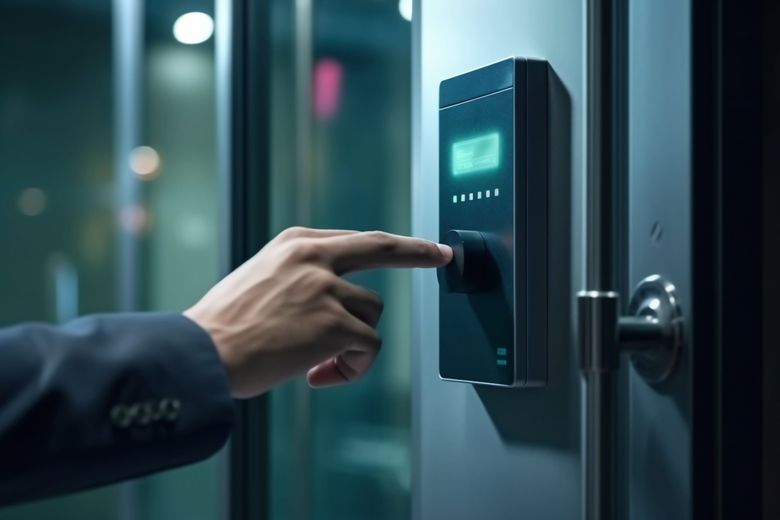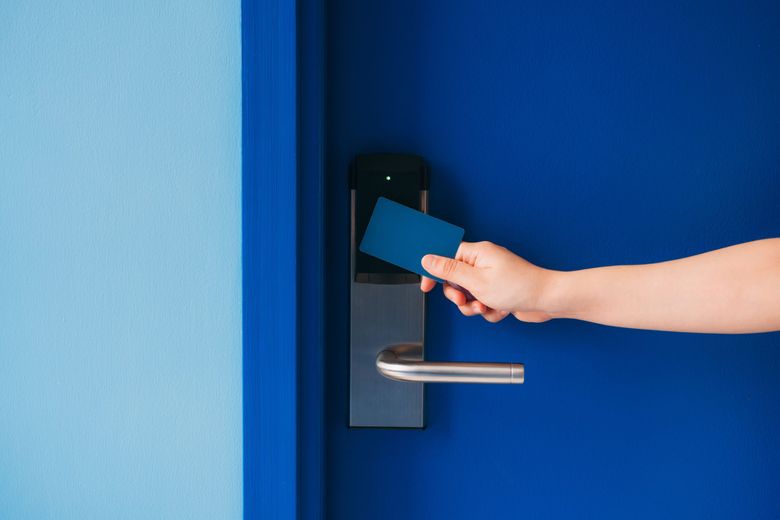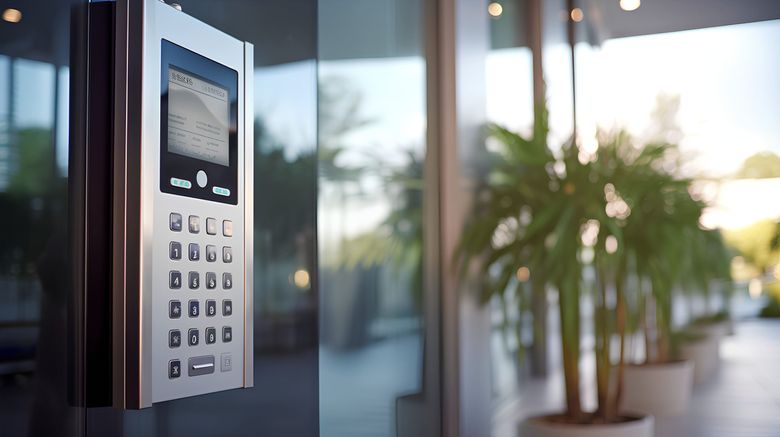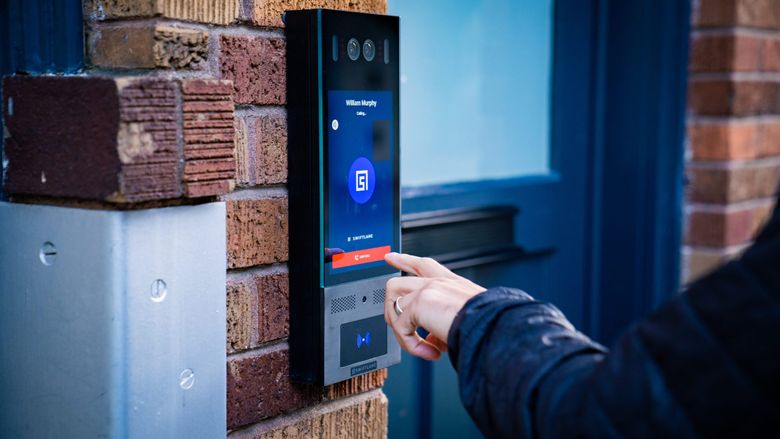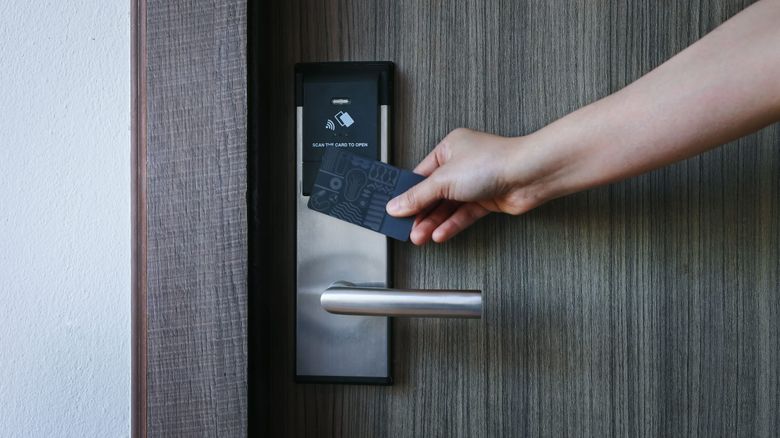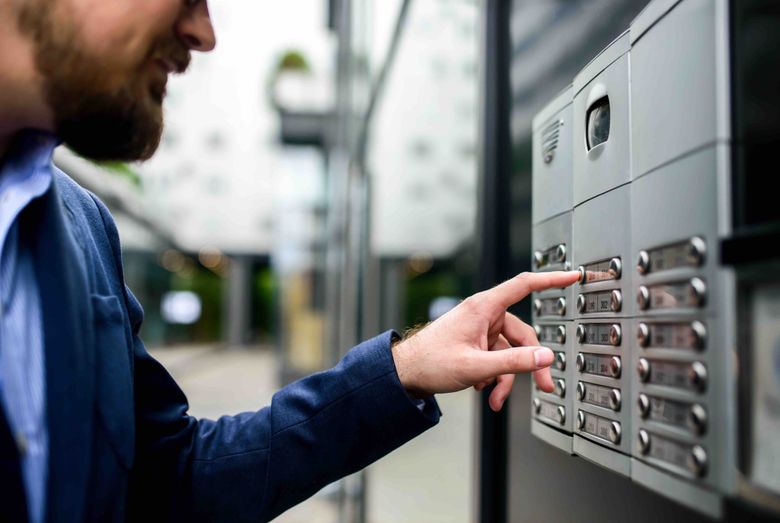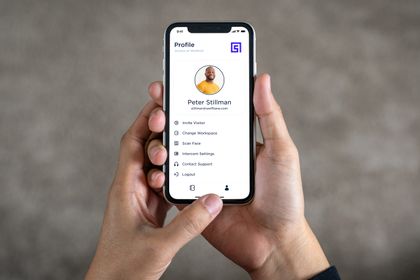Let’s Get Started!
In today’s fast-paced world, the need for keyless gate entry systems have never been more pressing. As our lives become increasingly interconnected through the digital realm, we find ourselves confronting new challenges and threats. Crime doesn’t wait for an invitation, and protecting your property is a commitment you can’t afford to neglect.
Gate locks are your first line of defense, guarding the boundaries of your domain. They serve as both a physical and psychological barrier, deterring potential intruders while providing peace of mind for homeowners and property managers alike. But the world of gate locks has evolved, and it’s time to embrace a smarter, more efficient approach: keyless entry.
Keyless gate entry locks are at the forefront of modern security solutions. These cutting-edge systems leverage the power of technology to provide convenience, flexibility, and enhanced protection. They eliminate the need for traditional keys, which can be lost, stolen, or duplicated, and replace them with state-of-the-art access control methods such as biometrics, passcodes, or smartphone apps.
In this article, we’ll unlock the secrets behind keyless entry gate locks and explore how they are redefining the landscape of property security. We’ll delve into the various types of keyless entry gate locks available, the benefits they offer, and the considerations you should keep in mind when choosing the right one for your property. So, whether you’re a homeowner looking to fortify your castle or a property manager seeking advanced security solutions, this guide will equip you with the knowledge you need to make an informed decision and secure your property like never before. Let’s embark on this enlightening journey into the realm of keyless entry gate locks, where security meets innovation in the most brilliant of ways.
Key Takeaways
- Keyless entry gate locks offer a convenient and secure way to control access to your property. With features like remote access and temporary codes, you can provide access to trusted individuals while maintaining control over who enters your property.
- These locks often support a variety of authentication methods, such as PIN codes, biometrics, or smartphone apps. This flexibility allows you to choose the most suitable option for your needs and adds an extra layer of security to your property.
- Many keyless entry gate locks can be monitored and managed remotely, providing peace of mind when you’re away from home. You can receive real-time notifications and even grant access to guests or service providers, making them a valuable addition to your property’s security system.
Suggested Posts
- Gate Intercom Systems | Guide To Choosing The Right One
- Package Theft Prevention | Your Guide To Home Security Upgrades
- Condos Vs. Apartments | Your Guide To Choosing The Right One
- How To Set Up A Package Room In 2023?
- The Best Cities To Buy Rental Property For Investment In 2023
Traditional Gate Locks vs. Keyless Gate Entry Locks
Gate locks play a crucial role in securing properties and controlling access to gated areas. Traditional gate locks, which include padlocks, deadbolts, and other mechanical locking mechanisms, have been the norm for many years. In recent times, keyless entry gate locks have gained popularity due to their convenience and enhanced security features. Let’s delve into a detailed comparison of these two types of gate locks.
Comparison of Traditional Physical Locks and Keyless Gate Entry Locks
Traditional Locks
- Traditional gate locks rely on physical mechanisms, such as keys, padlocks, and deadbolts.
- They require a physical key to operate, which can be lost or stolen, leading to potential security risks.
- These locks typically offer a lower level of convenience as they necessitate the presence of a physical key or combination of keys.
- Traditional locks are more susceptible to lock picking and tampering, making them less secure.
Keyless Entry Gate Locks
- Keyless entry gate locks use electronic components, such as keypads, RFID cards, or smartphones, for operation.
- They eliminate the need for physical keys, reducing the risk of key loss or theft.
- Keyless entry locks offer greater convenience as they allow authorized users to enter through a PIN, card, or smartphone app, which can be easily managed.
- They often incorporate advanced security features like encryption, temporary access codes, and audit trails to enhance security.
Limitations and Vulnerabilities of Traditional Locks
Traditional locks have several limitations and vulnerabilities:
Key Loss or Theft: One of the most common issues with traditional locks is the potential loss or theft of keys, which can compromise security.
Lock Picking: Traditional locks can be picked or bumped by experienced individuals, making unauthorized access relatively easy.
Inconvenience: Managing and distributing physical keys can be cumbersome, especially in cases where multiple people require access.
Lack of Audit Trail: Traditional locks do not provide any record of who accessed the gate and when, making it challenging to monitor and investigate security breaches.
Limited Access Control: Traditional locks offer limited control over who can access the gate and when, making it difficult to manage access for different individuals.
Advantages of Keyless Gate Entry Locks
Keyless entry gate locks offer several advantages:
Enhanced Security: These locks typically offer more advanced security features, such as encryption and temporary access codes, making it difficult for unauthorized users to gain access.
Convenience: Keyless entry systems eliminate the need for physical keys, offering a high level of convenience for authorized users who can enter using PINs, cards, or smartphone apps.
Access Control: Keyless entry locks allow for easy management of access rights, enabling property owners to grant or revoke access for specific individuals or during certain time periods.
Audit Trail: They provide an audit trail, which logs who entered and when, enabling property owners to track access and identify any suspicious activities.
Remote Access: Some keyless entry systems can be controlled remotely, allowing property owners to grant access to visitors or service providers even when they are not on-site.
Exploring Smart Lock Varieties: Integrating vs. Substituting Conventional Locks
Smart locks come in two primary categories: adapted and native, each with distinct advantages and installation requisites. Adapted smart locks offer a practical and cost-effective means of transforming your existing locks into keyless entry systems. Conversely, native smart locks entirely supplant conventional locks, resulting in seamless integration with smart home systems and advanced functionalities.
To assist you in determining the most suitable smart lock for your needs, let’s delve deeper into adapted and native smart locks, their merits, and the prerequisites for installation in each case.
Adapted Smart Locks
Adapted smart locks present an affordable and minimally invasive approach to upgrading to keyless access. They involve the integration of electronic components into your current locks, effectively converting them into smart door locks. This approach enables you to retain your existing locks while incorporating the desired smart features, offering an economical and non-disruptive solution.
Key benefits of adapted smart locks include
Compatibility with Existing Locks and Access Systems: These locks seamlessly blend with your current locking mechanisms and access control systems, ensuring a harmonious transition to keyless entry.
Smooth and Trouble-Free Migration to Keyless Access: Adapting your locks preserves the familiarity of your door while infusing modern access methods.
Affordable and Convenient Enhancement of Home Security: Adapted smart locks provide an economical and straightforward means of bolstering your home’s security.
Native Smart Locks
Native smart locks, in contrast, represent dedicated electronic locking systems designed to replace existing locks entirely, rendering them genuine smart door locks. They offer heightened security and additional functionalities when compared to adapted smart locks, contributing to a more secure and convenient user experience.
The installation process for native smart locks involves the removal of the existing lock and the installation of the new smart lock. This may impact the door and its frame, particularly if it is the front door. While some native smart lock manufacturers might provide a physical key as a backup, not all do, implying that, in some instances, the smart lock fully supplants the traditional key and door opener.
If you aspire to execute a comprehensive overhaul of your home security system, native smart locks could be the optimal choice for your requirements.
Types of Keyless Gate Entry Locks
Keyless entry gate locks have become increasingly popular due to their convenience, security, and flexibility. They eliminate the need for traditional keys and provide a variety of ways to access your gate. Here’s a detailed overview of the different types of keyless entry gate locks available in the market:
Electronic Keypad Locks
- Electronic keypad locks are one of the most common types of keyless entry gate locks.
- They consist of a numerical keypad where you enter a pre-programmed code to gain access.
- These locks are easy to install and offer a simple way to control who can enter your property.
- You can change the access code as needed.
- Some advanced models have features like temporary codes, one-time use codes, and anti-tamper mechanisms to enhance security.
Smart Locks with Remote Access
- Smart locks connect to your home’s Wi-Fi network and can be controlled through a smartphone app.
- They offer remote access, allowing you to lock and unlock your gate from anywhere with an internet connection.
- Smart locks can also integrate with other smart home devices, such as security cameras and voice assistants, for a more comprehensive home security system.
Biometric Fingerprint Recognition Locks
- Biometric locks use fingerprint recognition technology to grant access.
- Users must place their finger on a scanner to verify their identity.
- These locks are highly secure, as they rely on unique biometric data.
- Only authorized individuals with registered fingerprints can gain entry.
- Biometric locks can store multiple fingerprints, making them suitable for multi-user applications.
Proximity Card Readers
- Proximity card readers use RFID (Radio-Frequency Identification) technology to grant access.
- Authorized users carry proximity cards or key fobs, which they present near the reader to unlock the gate.
- These systems are convenient and can be integrated into larger access control systems for businesses or gated communities.
Bluetooth and Wi-Fi Enabled Locks
- These locks use Bluetooth or Wi-Fi to connect to your smartphone or other authorized devices.
- They often offer features like automatic unlocking when you approach the gate and access sharing with friends or family through a mobile app.
- Wi-Fi-enabled locks provide remote access and control, similar to smart locks.
Key Fobs
- Key fobs are small devices that can be carried on a keychain or in a pocket.
- They use radio signals to communicate with the gate lock and unlock it with a button press.
- Key fobs are user-friendly and a practical choice for people who prefer not to use a smartphone or remember PINs.
Mobile or App-Based Keyless Door Entry
- Some gate locks provide keyless entry via mobile apps. Users can simply tap a button on their smartphone to unlock the gate.
- App-based systems are convenient and can also offer features like time-limited access for guests and a history log of who entered and when.
Video Intercoms
- Video intercoms combine a camera and an audio system with the keyless entry lock.
- When a visitor arrives at your gate, you can see and communicate with them through a video call on your smartphone or a dedicated monitor.
- After verifying their identity, you can remotely unlock the gate to allow entry.
How Keyless Gate Entry Locks Work
Keyless entry gate locks have become increasingly popular for their convenience and security features. They provide a modern and sophisticated way to control access to homes, businesses, and other secure areas. In this detailed explanation, we’ll explore how keyless entry gate locks work, including the technology behind them, the role of PIN codes, biometrics, and access cards, their integration with home automation systems, and the measures taken to ensure encrypted and secure communication.
Technology Behind Keyless Entry Gate Locks
Keyless entry gate locks rely on a combination of advanced technologies to provide secure and convenient access control. Here’s an overview of the primary technologies involved:
Electronic Lock Mechanism: These locks typically feature an electronic locking mechanism, which replaces the traditional key and cylinder mechanism. This mechanism can be controlled remotely and powered by batteries or wired into the electrical system.
Keypad or Biometric Sensor: Most keyless entry gate locks include a keypad or biometric sensor as the primary means of authentication. These devices allow users to input a PIN code or use their biometric data for access.
Access Control Panel: An access control panel serves as the central control unit of the lock. It processes authentication data and decides whether to grant or deny access.
Communication Module: To facilitate remote control and monitoring, keyless entry gate locks often include a communication module. This module enables the lock to connect to the internet or a local network, allowing for remote access management.
Role of PIN Codes, Biometrics, and Access Cards
Keyless entry gate locks offer various authentication methods to grant access. These methods include:
PIN Codes: Users can enter a unique Personal Identification Number (PIN) on the keypad. The lock compares this PIN with a stored list of authorized codes. If the entered PIN matches an authorized one, the lock grants access.
Biometrics: Some advanced keyless locks feature biometric sensors, such as fingerprint scanners or facial recognition systems. Users must provide their unique biological data for authentication. If the sensor recognizes the biometric data, access is granted.
Access Cards: In commercial and residential settings, access cards (often RFID or NFC cards) are used as a convenient form of authentication. Users present their access cards to a reader, which sends the card’s information to the lock’s control panel for verification.
Integration with Home Automation Systems
Keyless entry gate locks are often part of a larger home automation ecosystem. They can be integrated with other smart devices and systems for increased convenience and control. Integration may include:
Mobile Apps: Many keyless entry gate locks come with mobile apps that allow users to control and monitor access remotely. Users can lock or unlock the gate using their smartphones.
Voice Assistants: Integration with voice-controlled assistants like Amazon Alexa or Google Assistant enables users to manage the lock using voice commands.
Camera Systems: Keyless entry gate locks can be linked to security cameras, allowing users to see who is at the gate and grant access if needed.
Integration with Alarm Systems: The lock can trigger alarm systems in case of unauthorized access attempts, enhancing security.
Ensuring Encrypted and Secure Communication
To protect against unauthorized access and data breaches, keyless entry gate locks implement several security measures:
Encryption: All communication between the lock, control panel, and other connected devices is typically encrypted to prevent interception and hacking. Common encryption protocols like SSL/TLS are used to secure data transmission.
Access Control: The lock’s control panel maintains a database of authorized users and their access privileges. Access control lists are carefully managed to ensure only authorized individuals can enter.
Physical Security: Keyless entry gate locks are designed to resist physical tampering, such as lock picking or brute force attacks. High-quality materials and mechanisms are used to enhance the lock’s durability.
Firmware Updates: Manufacturers release regular firmware updates to patch vulnerabilities and improve the security of their locks.
Advantages of Keyless Entry Gate Locks
Keyless entry gate locks offer several advantages, making them a popular choice for both residential and commercial properties. These locks utilize various methods such as PIN codes, biometrics, or remote access to control entry, eliminating the need for traditional keys. Here, we will explore the advantages of keyless entry gate locks in detail.
Convenience and Ease of Use
- Keyless entry gate locks provide an unparalleled level of convenience.
- Users can access the property without fumbling for keys, as all they need to do is enter a PIN code, use a fingerprint, or activate a remote control.
- This feature is particularly handy when carrying groceries, in bad weather, or when trying to access the property with your hands full.
- Additionally, many keyless locks have illuminated keypads or touch screens, making it easy to use at night.
Improved Security Features
- Keyless entry gate locks often come with advanced security features, such as encryption and anti-tampering mechanisms.
- These locks are typically more resistant to traditional lock-picking techniques, bumping, or drilling.
- With traditional keys, if they are lost or stolen, there is a risk that unauthorized individuals could gain access to your property.
- With keyless locks, you can easily change or update access codes or biometric information, reducing the risk of unauthorized entry.
Enhanced Control and Monitoring of Access
- Keyless entry gate locks allow property owners or managers to have precise control over who can access the property and when.
- They can easily set up and manage access codes or biometric profiles for specific individuals, granting temporary or permanent access.
- Some keyless locks even provide real-time access logs, allowing you to monitor who enters and exits the property and at what times.
- This can be valuable for security and accountability purposes.
Reduced Risk of Lockouts
- Traditional locks can result in lockouts if you forget your keys inside the property or lose them.
- Keyless entry gate locks eliminate this issue.
- You won’t ever need to worry about being locked out, as you can use your PIN, biometrics, or a remote to gain access.
- Additionally, some keyless locks offer backup access methods in case of technical failures, further reducing the chances of lockouts.
Integration with Security Systems
- Keyless entry gate locks can be seamlessly integrated with other security systems, such as surveillance cameras, alarm systems, and smart home automation.
- This means that when someone enters the property using a keyless lock, it can trigger other security features like sending a notification to your smartphone or recording video footage.
- Integration with a smart home system allows you to control the lock remotely, providing an extra layer of security and convenience.
Key Considerations When Choosing A Keyless Entry Gate Lock
Choosing the right keyless entry gate lock for your property is a crucial decision that affects your security and convenience. Keyless entry gate locks offer numerous advantages over traditional locks, but to make an informed choice, there are several key considerations you should keep in mind.
Before delving into specific features, you should evaluate your unique needs and preferences. Consider factors such as the level of security you require, your budget, and any special requirements you might have. Do you need remote access, smartphone control, or temporary access codes for visitors? Identifying your priorities will help you narrow down your options and make a more informed choice.
Compatibility with your gate type
- Not all keyless entry gate locks are compatible with every type of gate.
- Some locks are designed for swinging gates, while others are more suitable for sliding gates.
- Before making a purchase, ensure that the lock you choose is compatible with the design and dimensions of your gate.
- This compatibility ensures proper installation and functionality.
Weather resistance and durability
- Your keyless entry gate lock will be exposed to the elements, which makes weather resistance and durability critical.
- Look for locks that are rated for outdoor use and can withstand extreme temperatures, rain, and other environmental factors.
- Additionally, consider materials like stainless steel or hardened steel for longevity.
Power source and battery life
- Keyless entry gate locks typically rely on batteries for power.
- It’s essential to assess the type and quantity of batteries required and the expected battery life.
- Some locks come with rechargeable batteries, while others use traditional alkaline batteries.
- It’s important to select a lock that aligns with your willingness and ability to maintain and replace batteries as needed.
- Longer battery life can reduce the frequency of replacements.
Integration with your existing security infrastructure
- If you have an existing security system in place, consider how the keyless entry gate lock can integrate with it.
- Many modern locks offer compatibility with home security systems, enabling you to monitor and control the gate from the same central hub.
- This integration can provide a seamless and comprehensive security solution.
User-friendly interface
- The ease of use is a critical factor, especially if multiple individuals will be accessing the gate.
- Look for a lock with an intuitive interface and clear instructions for programming and operating.
- Some locks come with touchscreens or mobile apps, making it convenient for you and your family members to operate.
- Additionally, consider whether the lock offers options for multiple access codes, enabling temporary or one-time access for guests.
Security and Vulnerabilities in Keyless Entry Gate Locks
Keyless entry gate locks have become increasingly popular due to their convenience and enhanced security features. However, like any technology, they are not immune to security risks. In this detailed explanation, we will discuss the security measures and encryption protocols used in keyless entry gate locks, potential vulnerabilities, and how to mitigate them, and the importance of regularly updating and maintaining your lock’s firmware.
Security Measures and Encryption Protocols
Access Control Mechanisms: Keyless entry gate locks rely on various access control mechanisms, such as PIN codes, biometrics (like fingerprint or retina scans), or smartphone apps. These mechanisms provide a level of security by ensuring that only authorized users can gain access.
Strong Encryption: Modern keyless entry locks use strong encryption protocols to secure communication between the lock and the control device (e.g., a smartphone or a keypad). Advanced encryption, such as AES (Advanced Encryption Standard), is often used to protect data during transmission.
Randomized Codes: Many keyless locks generate randomized codes for each use. This makes it extremely difficult for an attacker to predict or intercept the code and gain unauthorized access.
Audit Trails: Some keyless entry gate locks include audit trail features, which log all access attempts and successes. This can help identify suspicious activity and ensure accountability.
Potential Vulnerabilities and Mitigation
Weak or Shared PINs: Weak PINs (e.g., 1234) or shared codes among multiple users can be a significant vulnerability. Mitigate this by requiring strong, unique PINs for each user, and periodically change them.
Biometric Spoofing: Biometric locks may be vulnerable to spoofing (e.g., using a high-resolution photograph to mimic a fingerprint). To mitigate this, use advanced biometric technology that can detect fake biometrics, or use multi-factor authentication for added security.
Smartphone Vulnerabilities: If the lock is controlled via a smartphone app, ensure your device is secure, with strong passwords or biometric authentication, and regularly update the app for security patches.
Network Vulnerabilities: If your lock is connected to the internet or a home network, it can be vulnerable to hacking. Mitigate this risk by securing your home network, using strong and unique Wi-Fi passwords, and keeping your lock’s firmware updated.
Physical Attacks: Physical attacks, such as drilling or tampering with the lock, are also potential vulnerabilities. Ensure your lock is installed properly and consider reinforcing the door or gate for added protection.
Importance of Firmware Updates and Maintenance
Regularly updating and maintaining your lock’s firmware is crucial for security. Firmware updates often include patches for known vulnerabilities and improvements in encryption protocols. Here are some key points:
Patch Vulnerabilities: Manufacturers release firmware updates to patch known vulnerabilities. Failing to update your lock’s firmware leaves it susceptible to exploits that have already been discovered and documented.
Enhance Security: Firmware updates may also include enhancements to encryption and access control mechanisms, providing better protection against evolving threats.
Maintain Compatibility: Keeping your firmware up-to-date ensures compatibility with other devices and applications, reducing the risk of incompatibility-related security issues.
Longevity: Regular maintenance and firmware updates can extend the life of your keyless entry gate lock, saving you money in the long run and preserving the security of your property.
Remote Access and Monitoring in Smart Keyless Entry Gate Locks
Smart keyless entry gate locks have revolutionized the way we secure our homes and properties. One of the key features that make these locks so attractive is their ability to offer remote access and monitoring. In this detailed exploration, we’ll delve into the benefits of remote access and monitoring in smart keyless entry gate locks, the role of mobile apps and remote control options, the importance of real-time notifications and alerts, and the convenience of remote access and temporary access codes for guests.
Benefits of Remote Access and Monitoring
Enhanced Security: Remote access allows homeowners to monitor and control their gate locks from anywhere in the world. This means that if you forget to lock your gate or need to grant access to someone while you’re away, you can do so easily, enhancing the overall security of your property.
Convenience: Smart keyless entry gate locks eliminate the need for traditional keys, which can be easily lost or stolen. Instead, you can use a mobile app or a remote control to lock and unlock your gate, making it incredibly convenient.
Increased Control: You have greater control over who enters your property. You can remotely lock and unlock the gate, view access logs, and even receive notifications whenever someone enters or exits. This level of control is particularly valuable for security-conscious homeowners.
Mobile Apps and Remote Control Options
Mobile Apps: Most smart keyless entry gate locks come with dedicated mobile apps that can be installed on your smartphone. These apps allow you to control the gate lock remotely. With the app, you can lock and unlock your gate, view access history, and make changes to user permissions.
Remote Control Devices: Some smart gate locks also come with physical remote control options, similar to a car key fob. These remotes offer quick and easy control of the gate lock without the need to use a mobile app.
Integration: Many smart gate locks can integrate with other smart home devices or platforms, such as Amazon Alexa, Google Assistant, or Apple HomeKit, providing even more flexibility in how you control and monitor your gate.
Real-Time Notifications and Alerts
Access Alerts: With remote monitoring, you can set up notifications to alert you in real-time when someone accesses your property. This can be particularly useful for keeping an eye on who enters or exits your premises, ensuring your property’s safety.
Tamper Alerts: Some smart gate locks also provide tamper alerts. These alerts notify you if someone tries to tamper with the lock, adding an extra layer of security.
Battery Status Alerts: Remote access allows you to monitor the battery status of your lock. You’ll receive alerts when the battery is running low, ensuring that you never get locked out due to a dead battery.
Remote Access and Temporary Access Codes for Guests
Guest Access: With remote access, homeowners can easily grant temporary access to guests, service providers, or contractors without having to be physically present. This is incredibly useful for Airbnb hosts, homeowners with frequent visitors, or those expecting deliveries.
Customized Permissions: Remote access often allows you to create customized access codes or permissions for different individuals. For instance, you can provide your house cleaner with a code that only works during specific hours or days, enhancing control and security.
Time-Limited Access: You can set up temporary access codes that expire after a certain period, ensuring that guests or service providers can’t access your property indefinitely.
Maintenance And Troubleshooting
Maintenance of a keyless entry gate lock is crucial to ensure its longevity and continued reliability. Regular maintenance not only extends the life of your lock but also prevents costly repairs or replacements. In this detailed guide, we’ll discuss the importance of regular maintenance for keyless entry gate locks and how to troubleshoot common issues that may arise.
Regular Maintenance for Keyless Entry Gate Locks
Cleaning and Inspection
- Start with a visual inspection of the keyless entry system. Look for any signs of wear, rust, or damage.
- Clean the keypad and touchpad regularly with a mild solution of soap and water. Avoid abrasive materials that can scratch the surface.
- Inspect the batteries for any signs of leakage or corrosion. Replace them as needed.
- Check the wiring connections and ensure they are secure. Loose connections can cause problems with the lock’s functionality.
Lubrication
- Keyless entry gate locks may have moving parts that require lubrication. Consult your lock’s user manual for specific instructions.
- Apply a recommended lubricant to the moving parts, such as the bolt or latch, to keep them functioning smoothly. Avoid using oil-based lubricants, as they can attract dust and debris.
Update Access Codes
- Change access codes periodically to enhance security. Make sure to keep a record of the codes in a secure place.
- If you have multiple users, update their access codes as necessary or revoke access for those who no longer need it.
Weatherproofing
- Ensure that the lock and keypad are properly sealed to protect against the elements. Weatherstripping and gaskets may need replacement over time.
- Clean and inspect any protective coverings or shields, and replace them if they are damaged.
Troubleshooting Common Issues
Keypad Not Responding
- Check the batteries first. Weak or dead batteries can cause the keypad to be unresponsive. Replace them with fresh batteries.
- Verify that the keypad is not dirty or damaged. Clean the keypad, and if it’s damaged, consider replacing it.
- Ensure the keypad is within the range of the lock’s wireless signal.
Incorrect Code Entry
- If the lock doesn’t respond to a correct code, ensure you’re entering it correctly. Pay attention to any specific instructions, such as the need to press a “Submit” or “Enter” button after the code.
- If the code still doesn’t work, reset the access code to ensure it hasn’t been accidentally changed.
Battery Drain Issues
- If the lock consumes batteries quickly, check for potential power-hungry features like a built-in Wi-Fi module. Disabling such features can prolong battery life.
- If battery drain persists, you may have a faulty lock that requires professional service or replacement.
Mechanical Issues
- If the lock’s bolt or latch doesn’t retract or extend smoothly, apply lubrication as mentioned earlier.
- Examine the strike plate on the gate frame and ensure it aligns properly with the lock. Adjust it if necessary.
Loss of Communication
- If the lock loses communication with its control unit, make sure it’s within the specified range. You may need to reposition the control unit for a better connection.
- Check for any sources of interference, such as electronic devices, that may disrupt communication.
User Lockout
- If you’ve been locked out due to too many failed code attempts, consult your user manual for instructions on resetting the lock or contact customer support.
Cost Analysis of Keyless Entry Gate Locks
Keyless entry gate locks are becoming increasingly popular for both residential and commercial properties due to their convenience, security, and the potential for long-term cost savings. To assess the cost implications of installing keyless entry gate locks, it is crucial to consider two primary aspects: the initial costs associated with purchasing and installing these systems and the potential savings over the long run.
Estimating the Initial Costs
Purchase Price: The initial cost starts with the purchase of the keyless entry gate lock system. These systems come in a range of styles and features, so the cost can vary significantly. The purchase price can range from $100 to $500 or more, depending on the complexity of the system and the brand.
Installation Fees: The installation of a keyless entry gate lock typically requires the services of a professional locksmith or a technician. Installation fees can vary, but you should budget around $100 to $200 for this service. It might be higher if the gate or door requires modifications to accommodate the new lock.
Additional Hardware: In some cases, additional hardware or accessories may be necessary, such as door sensors, Wi-Fi adapters, or cameras, which can add anywhere from $50 to $200 to the initial cost.
Maintenance and Support: Some keyless entry gate locks may come with ongoing maintenance and support fees, which could range from $20 to $50 annually.
The total initial cost of purchasing and installing keyless entry gate locks can range from $250 to $2000, depending on the specific lock system and any additional features or accessories required.
Comparing to Potential Savings in the Long Run
Reduced Key Replacement Costs: One significant long-term cost-saving benefit of keyless entry gate locks is the elimination of the need to replace lost or stolen keys. Traditional lock systems may require frequent rekeying or changing of locks, which can be expensive. Over time, this cost can add up to hundreds of dollars.
Enhanced Security: Keyless entry gate locks offer enhanced security features, such as encryption, access logs, and remote monitoring. These features reduce the risk of break-ins and theft, potentially saving you from costly property damage or losses.
Remote Control and Monitoring: Some keyless entry gate locks can be controlled remotely via smartphone apps, allowing you to grant access to visitors or service providers without being physically present. This can save time and travel costs.
Energy Efficiency: Certain keyless entry gate lock systems can integrate with smart home automation, allowing you to control lights, thermostats, and other devices. This can result in energy savings and potentially lower utility bills.
Reduced Wear and Tear: Traditional locks can wear out over time due to physical keys and locks being used frequently. Keyless entry gate locks have a longer lifespan as they do not have the same mechanical components that can wear out.
NOTE: In the long run, the potential savings with keyless entry gate locks can be substantial, considering the reduced need for key replacement, increased security, and the added convenience of remote access and control. These savings can vary depending on the specific use case and property type, but they are often significant and can outweigh the initial investment in a relatively short time.
Top 3 Companies To Choose For Keyless Gate Entry Systems
Swiftlane
Overview:
Swiftlane is a dynamic cloud-based access control system that integrates mobile unlock, face recognition, video intercom and visitor management for a secure, touchless access control experience. The SwiftReader is a compact solution used to secure any building, from small office spaces to high-rise residential buildings.
Most notably, Swiftlane was awarded the best new access control system by the Security Industry Association in 2020.
In 2021, Swiftlane was recognized several times in the Architizer A+ Product Awards.
Swiftlane Features:
- Touchless Access Control: Swiftlane provides touchless entry to doors using face recognition and mobile access technology. A person can just walk up the door, look at the reader and the door unlocks.
- Remote Management: Swiftlane’s cloud based access control is built to be managed from anywhere. The system is built to provide instant ability to add or revoke access, and connect with other systems like HR, employee identity and login providers, to automate the process of adding or removing users. This allows higher security and leaked access to people.
- Integrated Video Intercom: Most access control systems require installing and managing a separate intercom system for handling guests, which results in higher installation, training and operational costs. Swiftlane, however, has a built-in video intercom system for secure visitor management.
ADT Access Control
Overview
ADT is best-known for home security solutions, but their access control system, which is marketed by ADT Commercial, can fulfill basic security needs for small scale operations.
ADT Access Control Features
- Sensor-based central station monitoring
- Manned alarm monitoring and emergency response services
- Remote capabilities include lock/unlock, video monitoring, password management and system arm/disarm.
The Swiftlane Difference
Swiftlane’s mobile and biometric access credentials surpass the standard security parameters by operating from the cloud. Swiftlane Access Control plays a preventative role in security, as opposed to a reactive approach based in emergency response services. Additionally, our cloud-based platform allows admins to easily manage users from the dashboard instead of having to navigate through the vendor.
S2 Access Control
Overview
S2 is among the pioneers of web-based physical access control and security systems. Today, Lenel S2 positions itself as a unified security platform comprising access control, video surveillance, video security, and more.
S2 Access Control Features
- Unified security solution through S2 NetBox
- Supports legacy access control methods and many different integrations
- Video monitoring
- S2 Magic Monitor is a unified display interface that joins access control, video surveillance, live internet feeds, security events and alarms, credentials and access level management
- Mobile video management
The Swiftlane Difference
Swiftlane is a cloud-based access control system that operates without the need for an on-site server, which requires heavy operational overhead. The cloud-based system allows you to manage users through identity providers without integration, as well as perform functions remotely.
Let’s Wrap Up!
In a world where technology is constantly evolving, it’s no surprise that security measures are evolving with it. Keyless entry gate locks have emerged as a cutting-edge solution for enhancing the security of your property. As we conclude our exploration of this topic, let’s summarize the key takeaways and emphasize the importance of considering these advanced locks for your property.
Keyless entry gate locks offer a level of convenience and security that traditional locks simply can’t match. They eliminate the need for keys, which can be lost or copied, and instead provide access through personalized codes, fingerprint recognition, or smartphone apps. This means that you have precise control over who enters your property, and you can easily change access codes when necessary.
Moreover, keyless entry gate locks are user-friendly and adaptable to your specific needs. Whether you have a large estate, a small apartment, or a commercial property, there is a keyless entry solution that can be tailored to fit your requirements. They are weather-resistant and durable, ensuring that they stand the test of time, even in harsh outdoor conditions.
In closing, we encourage you to make an informed decision about the security of your property. Keyless entry gate locks are not just a technological marvel but a practical and efficient way to protect what matters most to you. Don’t wait until security becomes an issue; take action now to fortify your gates and ensure that only those you trust have access. Explore the options available, consult experts, and invest in the future of property security.
FAQs
How much does a keyless gate entry system cost?
The cost of a keyless entry system can vary significantly depending on various factors, including the type of system, its features, brand, and installation requirements. Here’s a breakdown of potential costs associated with keyless entry systems:
Basic Keypad Systems: Basic keyless entry systems that feature a numeric keypad for code entry are among the most affordable options. These can range from $50 to $200. However, their simplicity may limit the level of security they provide.
Smart Locks: Smart locks are more advanced and offer various features, such as remote access via smartphones, integration with home automation systems, and the ability to provide temporary access codes. The cost for smart locks can range from $100 to $400 for a single lock, and multi-lock systems can cost more.
Biometric Systems: Biometric keyless entry systems, which use fingerprints or retinal scans, are typically more expensive. These can range from $200 to $600 or more, depending on the brand and features.
Access Control Systems: For commercial or large-scale residential applications, full access control systems that manage multiple doors and users can range from $1,000 to several thousand dollars.
Installation Costs: Installation costs can vary depending on the complexity of the system and whether you hire a professional locksmith or do it yourself. Professional installation might cost an additional $100 to $300 per door.
Ongoing Costs: Consider any subscription fees associated with smart lock systems, especially if they offer cloud-based features or remote access.
What are the keyless gate entry methods?
Keyless entry methods offer alternatives to traditional physical keys. Here are some common keyless entry methods:
Numeric Keypads: Numeric keypads require users to enter a predetermined PIN code to gain access. These are simple and cost-effective.
Smartphone Apps: Many modern keyless entry systems allow users to unlock doors using their smartphones. Bluetooth or Wi-Fi connectivity is often used for this method.
Biometric Scanners: Biometric keyless entry systems use physical attributes like fingerprints or retinal scans for authentication.
Proximity Cards or Fobs: These systems work by waving a card or fob near the lock, allowing it to communicate with the access control system.
Remote Controls: Some keyless entry systems use remote controls, similar to those used for car doors, to unlock or lock doors from a distance.
Voice Recognition: Advanced systems employ voice recognition technology, where the user’s voice pattern is the key to access.
Facial Recognition: Facial recognition technology verifies a user’s identity by scanning and matching their facial features.
Bluetooth Keyless Entry: Many smart locks use Bluetooth technology to connect with smartphones, enabling users to unlock doors when they’re in close proximity.
How does a keyless gate entry system work?
Keyless entry systems work by using electronic or digital methods to authenticate and grant access to a secured space. Here’s a simplified explanation of how they work:
User Authentication: To gain access, a user must provide authentication, which could be a PIN code, a fingerprint, a smartphone signal, or another method.
Data Processing: The keyless entry system processes the provided data, whether it’s a PIN, biometric information, or a digital signal, to verify the user’s identity.
Access Control Decision: After verifying the user’s identity, the system makes a decision about whether to grant or deny access.
Lock Mechanism: If access is granted, the system sends a signal to the lock mechanism, which either unlocks the door electronically or disengages a physical bolt, allowing entry.
Logging and Monitoring: Many keyless systems log access events, providing an audit trail for security and monitoring purposes.
Remote Access: In the case of some smart locks, users can control access remotely using smartphones or other authorized devices, adding an extra layer of convenience and security.
What is the difference between key and keyless gate entry systems?
Key and keyless entry systems differ in several ways, including convenience, security, and functionality:
Physical Keys:
- Require a physical object (the key) for access.
- Can be lost, stolen, or duplicated without the owner’s knowledge.
- Offer limited control and tracking of access.
- May require lock replacements when keys are lost or security is compromised.
Keyless Entry Systems:
- Use electronic or digital authentication methods.
- Can be more convenient, as users don’t need to carry physical keys.
- Can offer multiple access methods like PIN codes, biometrics, smartphone apps, and more.
- Provide greater control over access, with the ability to grant temporary or one-time access to individuals.
- Offer advanced security features such as audit trails, remote access control, and monitoring.
Security
- Keyless systems can provide enhanced security features like biometrics, remote monitoring, and access control logs.
- Traditional keys are vulnerable to physical theft or duplication.
Convenience
- Keyless entry systems can offer greater convenience, especially with features like remote access and smartphone integration.
- Physical keys can be cumbersome to carry and may be misplaced.
Cost
- The initial cost of keyless entry systems can be higher, but they can offer long-term cost savings by eliminating the need for key replacements and rekeying.
Integration
- Keyless systems are often compatible with home automation and security systems, allowing for seamless integration.
Can keyless gate entry locks be hacked?
Keyless locks, like any technology, are not immune to hacking, but their security features make them generally more resilient to unauthorized access compared to traditional locks. Here are some considerations regarding the security of keyless locks:
Security Protocols: Most keyless entry systems use encryption and secure protocols to protect against hacking attempts. These measures make it difficult for hackers to intercept or manipulate the data exchanged between the lock and the authentication method.
Software Updates: Regular software updates are essential for maintaining security. Manufacturers often release updates to patch vulnerabilities and improve overall system security.
Physical Security: Even with electronic access methods, the physical security of the lock and the door itself are crucial. Intruders may attempt to bypass the lock through physical means rather than hacking the electronic components.
User Responsibility: Users must follow security best practices, such as regularly changing PINs or passwords and keeping authentication methods secure (e.g., not sharing smartphone access with unauthorized individuals).
Potential Vulnerabilities: While rare, keyless entry systems may have vulnerabilities that could be exploited by determined hackers. This is why it’s essential to choose reputable brands and regularly update the firmware.



